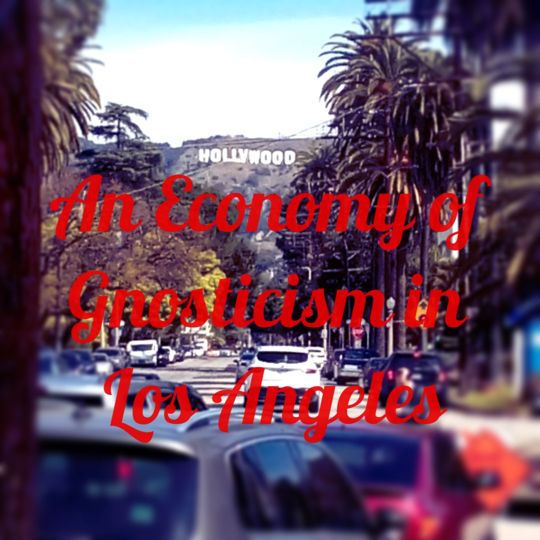Los Angeles, California, is the only place in the world today that all four gnostic religions are active. I recently had the chance to do some fieldwork there. Contemporary gnostic religions have had little attention from scholars. By “gnostic religions”, I mean, quite simply, groups who describe themselves as both “gnostic” and a “religion”. I’m sure many scholars will disagree with both of these designations, but it’s a complicated question and so I’ll address this in a future post. For now, the four groups I am talking about are the Ecclesia Gnostica, the Apostolic Johannite Church, the Ordo Templi Orientis and the Gnostic Movement of Samael Aun Weor.
If I were a certain kind of scholar, I might speculate that there is so much gnosticism in LA because Hollywood is the symbolic centre of the archonic media matrix where the illusory world of the demiurge is created. More prosaically, LA has long been a centre for religious innovation due to being multicultural, liberal and relatively cheap. People were going West in search of new ways of life long before the Hippies emerged from Haight-Ashbury to catalyse the spiritual revolution of the New Age movement. Moreover, contemporary gnostics mix esoteric ideas with Christianity, and so appeal much more to American Baby Boomers than to their relatively secularised European counterparts.
For example, the Ecclesia Gnostica performs a Gnostic Mass weekly in the Besant Lodge of the Theosophical Society, a converted silent movie theatre underneath the Hollywood sign. If you didn’t look closely at the portraits of Theosophical founders on the wall, or recognise the Jungian additions to the liturgy, you might not realise this wasn’t a regular Anglican ceremony. Services have been performed weekly by Bishop Stephan Hoeller, now aged 87, since 1977. Hoeller’s gnosticism is a formalisation of the ideas of depth psychologist Carl Jung, a process of reuniting with the divine aspect of the self.
While they have some associated groups, the Ecclesia Gnostica is largely confined to Los Angeles. This isn’t the case with the other groups. The Apostolic Johannite Church, for example, have a number of branches around North America, though they are currently strongest in Canada. They also focus on a liturgical mixture of Christian and esoteric traditions, though here the focus is more on a Rosicrucian rather than Jungian tradition. Interestingly, their presence in LA is not as strong as in other major US cities, probably because the Ecclesia Gnostica has been so successful there. The Apostolic Johannites are keen to stress their appreciation for and connection with the Ecclesia Gnostica, but this is not reciprocated.
The high degree of competition in the gnostic marketplace also affects the Gnostic Movement, a loosely connected constellation of groups stemming from the teachings of Columbian teacher Samael Aun Weor in the 1960s and early 1970s. Although relatively recent in comparison, and originating in Spanish-speaking areas, the Aun Weor groups have been the most successful in spreading internationally, with small but constant presence in many European countries. Last year, I undertook their First Chamber (a series of 33 introductory lectures) with a group in Edinburgh, which also deserves its own post. But in LA, these groups cater in the main to a Hispanic clientele, which is a large proportion of the population of this bilingual city. In Europe, most Gnostic Movement groups present the material in a form more appealing to a New Age or individualised spirituality discourse, though there is always a clear Christian aspect, and indeed there are some groups which perform the Gnostic Mass and dress in vestments just like the Ecclesia Gnostica (notably the Igreja Gnostica do Brazil). So perhaps the adaptive framing of the Gnostic Movement is the reason it has spread in the Americas and Europe, unlike the other contemporary gnostic religions.
The fourth and final example is least likely to be accepted as a gnostic religion, by scholars and the other groups, in large part as a result of its infamous founder, Aleister Crowley. Yet the Ordo Templi Orientis, or rather its ecclesiastical wing, the Ecclesia Gnostica Catholica, has many features in common with them: performance of the Gnostic Mass, roots in late Victorian occultism and claims of apostolic succession – that is, a direct lineage of bishops back to St Peter. The Pasadena branch, the Star Sapphire Lodge, put on public performances of Crowley’s version of the Gnostic Mass weekly. Yet, as with the Gnostic Movement, the modern OTO is more concerned with legitimising themselves among competing Thelemic groups through connections to their founder, rather than apostolic succession, as with the Ecclesia Gnostics and the Apostolic Johannites. However, it is clear that their use of sexual magic is as much of a problem, however, and there is open hostility towards the OTO and the Gnostic Movement from the apostolic gnostic religions.
Los Angeles, then, is a microcosm of contemporary gnostic religion. More, it is a microcosm of the complex genealogy of the term gnosticism with its Christian and esoteric usages, the influence of Jung and other perennialist scholars, and its selective but enduring charm.

